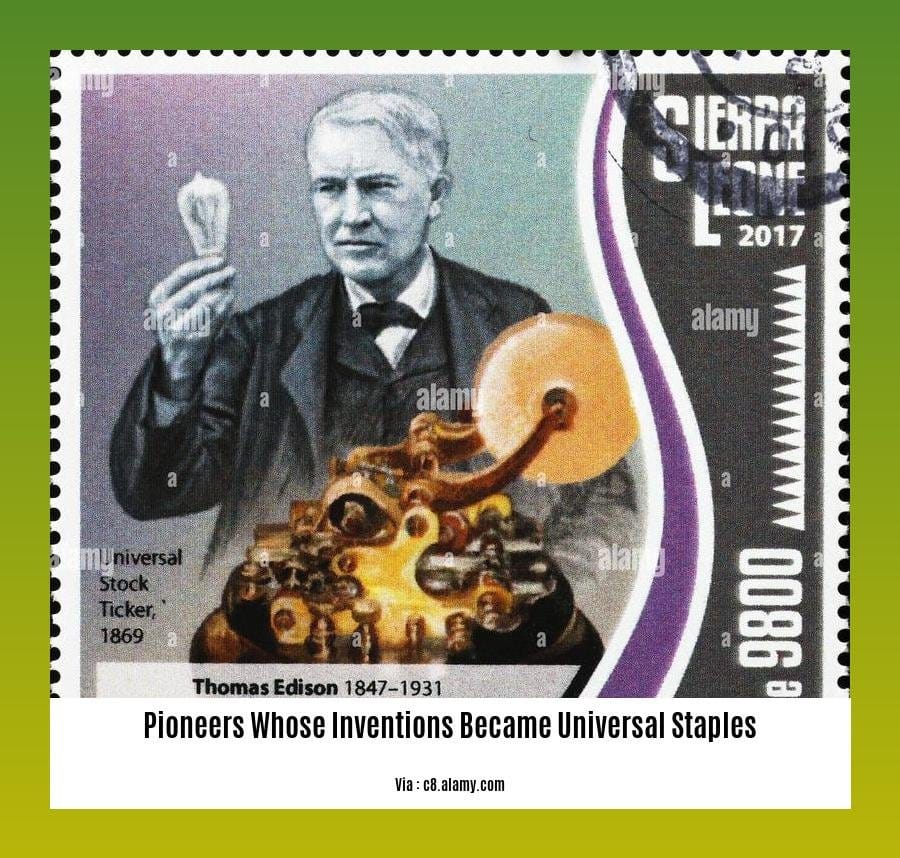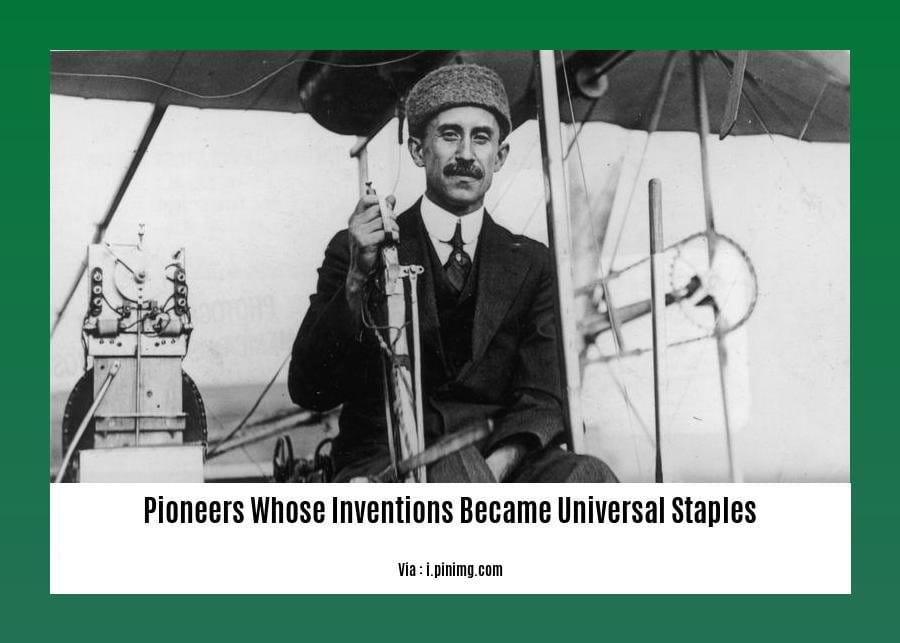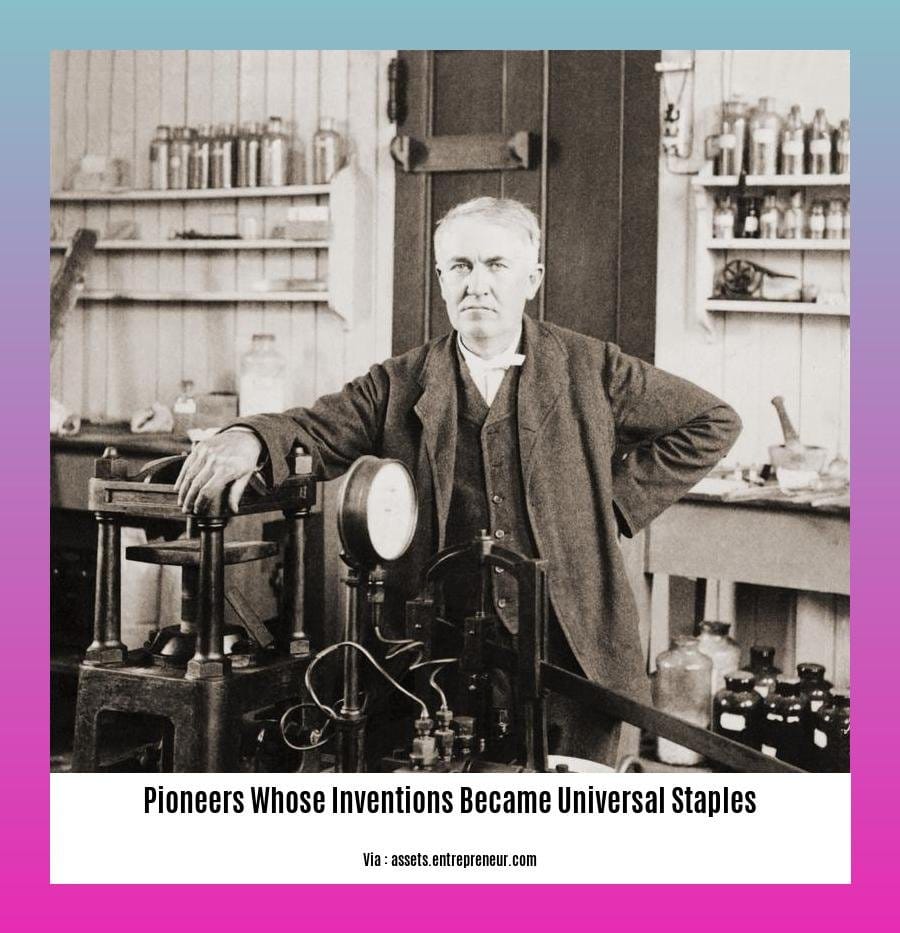In the realm of innovation, countless minds have toiled tirelessly to bring forth inventions that have irrevocably transformed our lives. From the humble beginnings of these groundbreaking creations to their ubiquitous presence in our daily routines, the stories of these visionary pioneers and their universal staples are a testament to human ingenuity and the power of invention. In this article, we delve into the lives and legacies of these extraordinary individuals, exploring the scientific breakthroughs, societal impacts, and personal journeys that have shaped the technological landscape of our world.
Key Takeaways:

- The first stapler was designed for royalty, with staples bearing the royal seal.
- A “true” stapler, using a binder-like staple, was patented in 1866.
- George McGill’s 1866 stapler was limited in capacity and functionality.
- The 19th century saw a surge in stapler development due to increased paper usage.
Trailblazers Whose Inventions Became Universal Staples
Our world is shaped by pioneers whose inventions became universal staples, transforming our daily lives and creating conveniences we often take for granted. Let’s explore the stories behind some of these remarkable innovators:
Thomas Edison: Lighting Up the World
Before Edison’s incandescent light bulb, homes and businesses were dimly lit by candles and gas lamps. His invention revolutionized lighting, making it brighter, safer, and accessible to all.
Alexander Graham Bell: Connecting the World
Bell’s telephone connected people across vast distances, enabling real-time conversations. It transformed communication, revolutionizing businesses, social interactions, and emergency services.
Eli Whitney: Revolutionizing Cotton Production
Whitney’s cotton gin dramatically increased the efficiency of cotton processing, making it a more profitable crop. This invention played a pivotal role in the rise of the textile industry.
Henry Ford: Paving the Way for Mass Transportation
Ford’s Model T Ford made automobiles affordable for ordinary people. His assembly line production techniques forever changed the way we travel and work, democratizing transportation.
Marie Curie: Unlocking the Secrets of Radium
Curie’s discovery of radium opened new frontiers in medicine and science. Its radioactive properties led to advances in cancer treatment, x-ray technology, and atomic physics.
These pioneers, among others, left an indelible mark on our world. Their inventions became universal staples, shaping the course of history and continuously improving our lives. They inspire us to continue innovating, striving for progress that will benefit generations to come.
The innovators of everyday items we take for granted, the pioneering minds behind ubiquitous conveniences, and the inventors of deceptively simple everyday objects have shaped our world in countless ways.
Eli Whitney: The Cotton Gin
Eli Whitney’s cotton gin was a revolutionary invention that made cotton production much more efficient. Before the cotton gin, cotton had to be cleaned, or ginned, by hand, which was a slow and labor-intensive process. Whitney’s machine could do the work of 50 people, making it much more profitable to grow cotton.
Whitney’s invention had a profound impact on the United States. The South became the world’s leading cotton producer, and cotton became the country’s most important export. The cotton industry also led to the growth of slavery, as planters needed more and more workers to harvest and process the cotton.
The cotton gin also had a significant impact on the global economy. Cotton became a major commodity, and it was used to make clothing, bedding, and other products. The cotton trade also helped to connect the United States to the rest of the world.
Key Takeaways:
- Eli Whitney invented the cotton gin in 1793.
- The cotton gin made cotton production much more efficient.
- The cotton gin led to the growth of the cotton industry in the United States.
- The cotton industry had a profound impact on the United States and the global economy.
- The cotton gin also strengthened the economic foundation of slavery in the Antebellum South, as it made upland short cotton a profitable crop.
Citation:
- History.com: Cotton Gin and Eli Whitney:
Henry Ford: The Automobile
Henry Ford transformed transportation with his ingenious approach to the automobile industry. His introduction of the Model T Ford in 1908 made cars accessible to the masses, forever changing how people lived and worked.
Ford’s Assembly Line Revolution
Key Takeaways:
- Ford implemented assembly line production, slashing manufacturing costs.
- The Model T Ford became affordable for the middle class, democratizing transportation.
- Ford’s innovations revolutionized the auto industry and mass production techniques.
Legacy: From Tin Lizzie to Industry Titan
Ford’s Model T, affectionately known as “Tin Lizzie,” became a cultural icon and a symbol of American industrial prowess. His commitment to efficiency and affordability transformed the auto industry and paved the way for the modern transportation system we rely on today.
Citation:
Marie Curie: Radium
Marie Curie, a renowned scientist, played a pivotal role in the discovery of radium. Her groundbreaking work revolutionized the field of medicine and science.
The Discovery of Radium
In 1898, Marie and Pierre Curie, her husband, embarked on a journey to isolate radium. After years of meticulous research, they successfully extracted radium salts from pitchblende in 1902. This groundbreaking discovery marked a turning point in the understanding of radioactivity.
Medical Advancements
Radium’s unique radioactive properties opened new avenues in medicine. Curie recognized its potential in treating cancer. By harnessing radium’s ability to target and destroy cancerous cells, she paved the way for the development of radiation therapy. This treatment has since become a cornerstone in the fight against various types of cancer.
Contributions to Science
Curie’s work on radium not only had medical implications but also contributed significantly to the field of science. Her research laid the foundation for the study of atomic physics and nuclear chemistry. Radium’s radioactive properties provided scientists with a glimpse into the inner workings of atoms and the potential for nuclear reactions.
Key Takeaways:
- Marie Curie and Pierre Curie discovered radium in 1898.
- Radium’s radioactive properties led to advances in cancer treatment and the understanding of atomic physics.
- Curie shared the Nobel Prize in Physics with Becquerel in 1903 for their discovery of radioactivity.
Citation: Britannica, The Editors of Encyclopedia. “Marie Curie and Irene Curie on Radium.” Encyclopedia Britannica,
Accessed 27 February 2023.

FAQ
Q1: Who invented the first stapler, and what made it unique?
A1: The first stapler was created for King Louis XV of France in the 18th century and was distinctive for bearing the royal seal on each staple.
Q2: How did the cotton gin impact the economy and society in the Antebellum South?
A2: Eli Whitney’s cotton gin revolutionized cotton production, making upland short cotton a profitable crop and strengthening the economic foundation of slavery in the region.
Q3: Why was Henry Ford’s transmission mechanism so significant in the automobile industry?
A3: Henry Ford’s transmission mechanism, patented in 1911, enabled the efficient production of automobiles on assembly lines, making them affordable for the middle class.
Q4: What role did Marie Curie play in the discovery of radium?
A4: Marie Curie, along with her husband Pierre Curie, discovered the presence of radium and polonium in pitchblende in 1898 and successfully isolated radium salts in 1902.
Q5: How did the invention of the stapler contribute to the widespread use of paper?
A5: The 19th century saw a surge in stapler development due to the increasing availability of paper, making it easier to bind and organize documents.
- Red Cross Flag: Protecting Humanity Through History - April 19, 2025
- China II Review: Delicious Food & Speedy Service - April 17, 2025
- Understand Virginia’s Flag: History & Debate - April 17, 2025
















